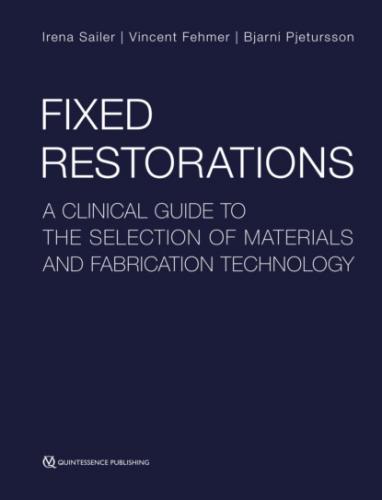Fixed Restorations. Irena Sailer
∆E, calculated between the modified and unmodified soft tissues for each picture, and the evaluations of the different groups of observers, the respective threshold values for the perception of soft tissue color changes were assessed23. The study showed that our human eyes are sensitive to soft color differences, and soft tissue discolorations are equally perceived by professionals and laypeople23. Consequently, soft tissue discoloration caused by the restorative material can lead to the esthetic failure of the restoration and the restorative material has to be selected carefully.
The soft tissue color can be a critical factor for the esthetic outcome of a restoration both at non-vital discolored abutment teeth and at implant-supported restorations. In some situations, the restorative material is not capable of improving pre-existing discolorations. It has been shown that at non-vital abutment teeth, the soft tissue color was not related to the restoration material, ie, the post-and-core material or the prosthesis24. The soft tissue color could not be influenced, neither positively by white root post nor negatively by dark root posts24. Hence, in clinical situations with discolored non-vital abutment teeth, existing soft tissue discolorations have to be accepted to some extent as an esthetic compromise of the new restorations (Fig 1-2-4). An alternative solution is to augment the thickness of the buccal soft tissues with connective tissue grafts.
Fig 1-2-4 Clinical case example showing the different outcomes of two zirconia-ceramic crowns on the vital abutment of the maxillary right central incisor, and the non-vital, discolored abutment of the left central incisor (note the grayish shadowing at the gingiva).
With implant-supported restorations, the selection of the material of the prosthetic components exhibits an influence on the soft tissue color. Titanium implant abutments and metal-ceramic implant restorations can lead to dark, grayish peri-implant soft tissue discoloration, as has been shown in several clinical studies21,22 (Fig 1-2-5). The thickness of the soft tissues was identified as crucial parameter for the presence or absence of the soft tissue discoloration. A minimal soft tissue thickness of 2 mm was defined as the threshold value for the color influence22.
Fig 1-2-5 Grayish discoloration of metal-ceramic implant crown of the maxillary left first premolar, supported by a titanium abutment.
At a soft tissue thickness of >2 mm the material selection and, hence, color of the implant restoration is less critical for the esthetic outcome. Still, in patient cases with thin soft tissues and anterior implant-supported restorations, the use of ceramic abutments and all-ceramic restorations is recommended (Fig 1-2-6).
Fig 1-2-6a to 1-2-6e All-ceramic implant single crown supported by a veneered customized zirconia abutment for the replacement of the maxillary left lateral incisor.
1.2.6 Occlusal and functional requirements
Prior to restoring compromised teeth or replacing missing teeth with fixed or removable dental prostheses, a thorough occlusal analysis has to be performed, as Part of the initial clinical examination. Occlusion and function play a significant role for the long-term behavior of all-ceramic restorations.
The basic principle of occlusion is to distribute the occlusal load as much as possible on all teeth and/or restorations. Premature occlusal contacts have been shown to increase the muscular activity during mastication25–28. Hence, any contact or restoration that causes elevate muscular activity can cause muscle tenderness and even lead to TMD25,29. On restorations, premature contacts increase the risk for technical complications. The occlusal load should preferably follow the long axis of teeth and implants and horizontal load should be avoided as much as possible30–33. The height of the cusps should be enough to break up the food.
Occlusal concepts and their focus have changed over the years. They can broadly be classified into three categories: bilateral balanced occlusion, unilateral balanced occlusion (group function), and mutually protected occlusion (canine guidance).
The concept of bilateral balanced occlusion is to have as many teeth as possible in contact, both in maximal intercuspal position (MIP) and in all excursive positions. This is very difficult to achieve in the natural dentition and can cause additional tooth wear on the balance side. Bilateral balanced occlusion has been propagated for removable prostheses to maintain better denture stability. More recent studies on edentulous patients with conventional dentures have, however, not been able to show that bilateral balanced occlusion significantly increases the chewing capacity compared with patients wearing dentures with unilateral balance occlusion34–36.
In the concept of unilateral balanced occlusion, multiple teeth in the maxilla and mandible, both anterior and posterior, on the working side are in contacts during lateral movements. The idea is that simultaneous contact of several teeth acts as a group to distribute occlusal load and by that may reduce the risk of trauma from occlusion and fracture or chipping of the restoration. No teeth on the balanced side should be in contact and during protrusive movements there should also be no posterior contacts. Long-centric or freedom in centric has been propagated as a Part of unilateral balanced occlusion, especially by patients in whom MIP and centric occlusion (CO) are not identical37–39. This allows for a certain freedom of movement (0.5–1.5 mm) in the anterior-posterior direction.
The concept of mutually protected occlusion assumes that MIP = CO and that the six anterior teeth in the maxilla and mandible guide the excursive movements of the mandible, and that the posterior teeth only come into contact in CO.
Evaluation
The following factors have to be evaluated and registered.
Centric relation
Centric relation (CR) should be evaluated. CR is defined as the maxillo-mandibular relationship, independent of tooth contact, in which the condyles articulate in the anterior-superior position against the posterior slopes of the articular eminences. In CR, the mandible is restricted to a purely rotary movement, so this is a repeatable reference position.
Centric occlusion
Centric occlusion (CO) should be registered
